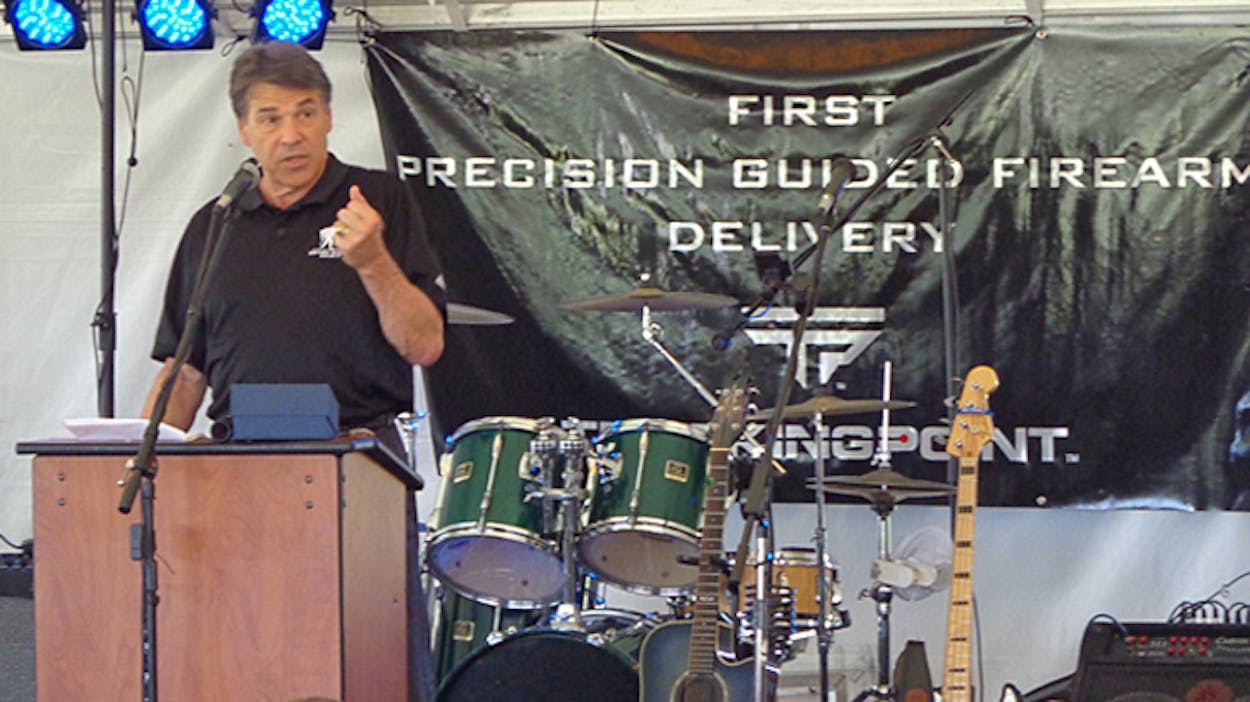“Let it be known that on May 15, 2013, in Mason, Texas, history has been made.” So declared John McHale, Austin-based millionaire investor, entrepreneur, and founder of TrackingPoint, Inc, a company in the history-making business via space-age gun technology. McHale was addressing the 100 or so people gathered before him beneath a white tent almost large enough to be worthy of Michael Jordan’s wedding.
Everyone was gathered to celebrate the official, public release of TrackingPoint’s signature technology: Precision Guided Firearms (PGF). In a nutshell, PGF straps the laser-guided targeting system of a jet fighter onto a high-powered rifle with the user-friendly interface of a smartphone app. “It’s got more software than the space shuttle,” McHale said without hyperbole. It had been two years since the company’s launch, and today was the day to let loose, enjoy the open bar and Cooper’s barbecue (from nearby Llano), exchange accolades, and shoot some enormous and powerful guns.
The festivities, which included a Fleetwood Mac-loving country band, were taking place on McHale’s 4,000-acre ranch just outside of Mason, more than 120 miles west of Austin. Guests had arrived to the back lawn of McHale’s palatial log cabin-cum-mansion by car, charter shuttle, and helicopter. Engineers, tech geeks, salespeople, and marketing wonks mingled with gun evangelists, wealthy sports hunters, a couple of war heros, and invited guests—REI chairman John Hamlin, Austin Venture capitalist Paul Zito, GSD&M co-founder Steve Gurasich, and Governor Rick Perry.
After a congratulatory speech lauding his employees and investors, McHale introduced Perry as “the greatest governor the state has known, . . . an avid outdoorsman, . . . and an all around good guy” before awarding the governor the First Annual TrackingPoint Founders Award for his efforts to protect Second Amendment rights in Texas. McHale’s fondness for Perry, one can presume, is what led him to donate $50,000 to the governor’s last campaign after years as a consistently Democratic donor. The friendship seems mutual; Perry told the crowd he was at McHale’s home when he first heard of the concept for the PGF four years ago. “I thought it was really cool,” said Perry. “[McHale] explained it to me in a way that I could understand. He said, ‘Perry, we’re gonna build a rifle that is Aggie-proof,’ and damned if he didn’t.”
The PGF technology seems capable of making any shooter into a marksman. Glenn Banton, vice president of customer development at Chaotic Moon Studios, which helped develop the software for the PGF, told me that the gun allows a user to shoot as accurately as though they had practiced extensively. “I call this thing the ‘smile machine’ because you can shoot one round, giggle about it, and go home,” said Banton.

Cutting down on training time may be attractive to the Pentagon. PGF could enhance American soldiers, TrackingPoint’s incoming CEO Jason Schauble said. “I think of it less as ‘How do I make the elite marksmen better?’ and more as, ‘How do I make every soldier better?'” Perry echoed these sentiments. “[TrackingPoint] has created a piece of equipment that is going to save American lives on the battlefield,” he said. While it seems tailor-fit for warfare, Schauble noted that the current economic state of the country precludes any military procurement for new weapons systems. And these guns aren’t cheap: they currently go for $20,000 to $30,000.
So, who will be using PGF technology? Currently the price tag points towards a very specific clientele: big game hunters and technology enthusiasts with deep pockets. But TrackingPoint is partnering with Remington Arms Company to broaden their market share. Schauble said a version of the PGF could be available for less than $5,000 in big box stores as soon as next hunting season.
Does the governor plan to own a precision-guided firearm himself? “A boy can always dream,” Perry said. For his part, the governor used the occasion to boast of TrackingPoint as evidence that Texas is one of the most attractive places in the country for businesses: “Companies are looking at Texas and thinking about what the country will look like in ten years—Where are we going to move or expand? They’re looking here.”
Indeed, TrackingPoint drew high-tech talent from across the country to Texas in order to, they say, “advance the science [of firearms] by 100 years.” But TrackingPoint didn’t invent a new type of gun so much as they created new software to control them. Banton pointed out that most of the components of the PGF have been available for years, if not decades; the PGF’s true innovation lies in the consolidation of big ideas into such a little package. “The future’s already here, you just have to put the pieces together,” Banton said. If Perry is right, business is the best glue.






